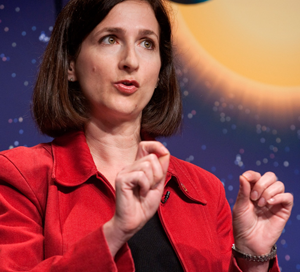Search for Exoplanets: A Discussion with Professor Sara Seager
One of the most existing developments of the last two decades in the field of astronomy is the discovery of exoplanets: planets that orbit around the stars other then our sun. The idea of finding planets outside our solar system is not new; philosophers and scientists have imagined exoplanets for centuries. Giordano Bruno, an Italian philosopher, mathematician, poet, and astrologer theorised exoplanets in sixteenth century. However for centuries there was no mechanism available to detect exoplanets. The first two confirmed exoplanets were discovered in 1992. Since then the detection of new exoplanets continues. By September 2015 the number of confirmed exoplanets reached 1892. In this podcast I discuss in detail, with Professor Sara Seager, the fascinating research in the field of exoplanets.
Professor Sara Seager is an astrophysicists and planetary scientist at MIT. Her science research focuses on theory, computation, and data analysis of exoplanets. Her research has introduced many new ideas to the field of exoplanet characterization, including work that led to the first detection of an exoplanet atmosphere. Professor Seager is the author of two textbooks on these and relevant topics. She was part of a team that co-detected light emitted from an exoplanet first time, and the first spectrum of an exoplanet. In twenty thirteen she was awarded a MacArther Fellowship. I open our conversation by asking professor Seager about her education, and about her career and that how did she get there, where she is now.
As planets don’t emit light, and are usually very small as compared to their host stars, it is very hard to directly detect exoplanets. Scientists have solved this problem by developing indirect techniques for detecting exoplanets. Tq1wo main indirect techniques to detect exoplants are: Transit Method and Radial Velocity methods. Transit method is based on the detection of dimming of host star’s light when an exoplanet moves infornt of the host start. Radial velocity method, also known as Doppler Spectroscopy, is based on the fact that when a star is orbited by an exoplanet, it does not remain completely stationary; it moves in a small circle or ellipse due to the gravitational tug of the exoplanet. Professor Seager explains these two techniques for detecting the exoplanets indirectly.
Radial velocity method of detecting exoplanets works well to look for planets in our immediate galactic neighbourhood, say up to 100 light years from Earth. Transit method can potentially detect planets at a distance of hundreds of light years. However Gravitational Micro-Lensing can be used to detect planets at a distance of thousands of light years, near the centre of Milky Way galaxy.
Professor Seager discusses in detail the Gravitational Micro-Lensing phenomenon that occurs due to the gravitational lens effect. Gravitational Micro Lensing can be used to detect objects in space at great distances from the Earth. One of the insights of Einstein’s theory of general relativity is that gravity bends space. Light travels in straight line; however when light moves through a region of space that is warped by the presence of a massive object, the light rays become bent. Thus the presence of a massive object, and warped space around it can act as a lens, which bends the light of the bright background object. This phenomenon generates magnified and brightened images of the background. The massive object in this setting works as a lens and the background as a source whose magnified image can be acquired. Professor Seager explains that how Gravitational Micro Lensing can be used to detect exoplanets.
One of the main sources of data that has lead to the discovery of large number of exoplanets is the Kepler Space Telecope. The Kepler Space telescope is positioned at a fixed point in space, and is pointed at a fixed region of sky, and it keeps taking images, keeps gathering data for that particular patch of sky. Professor Seager explains main features of the Kepler Space Telescopes and describes its significance in the field of research on exoplents.
In her publications and presentations Professor Seager discusses a new idea, a preferred way of finding and studying exoplanets. The proposed system is composed of a space telescope and an accompanying star shade, where the star shade is positioned in-between the telescope and a distant star. The shade will block the light of the star and the telescope will then be able to see the light reflected from the exoplanet. Professor Seager explains this proposed system of a space telescope and a star shade, and the current status of this proposed system.
Perhaps one of the most fascinating aspects of research on exoplanets is trying to find exoplanets in habitable zone and to look for Earth like exoplanets. Habitable zone is a region of space where conditions are best for life, not too hot, not too cold, but just right. However recent research in the field of extremophiles informs us that life can exist in extreme environments. Professor Seager explains the concept of habitable zone, and discusses the search for exoplanets in habitable zones. At that point I ask professor Seager about the term “earth like exoplents”; professor Seager describes this term from the perspectives of an exoplent with similar size, similar temperature, pressure, with similar duration of a day and year.
Another interesting and important aspect of Professor Seager’s research is to model, and to study exoplanet atmosphers. The aim is to understand the atmospheric composition and the temperature of exoplanets. Professor Seager suggests in her publications that transit observations of exoplanets can be used to model planet’s atmosphere, and can be used to detect presence of gases and clouds. Professor Seager discusses this aspect of her research. It is fascinating to note that to model the atmosphere of an exoplanet, the main source of data comes from the tiny amount of observed light that passes through the atmosphere of the exoplent when it passes in front of the host start. Professor Seager discusses the process of gathering this tiny amount of light, and the equipments capable of capturing this light. The next obvious question is that can the composition of the interiors of exoplanets be studied using this transit date.
The next obvious step is to try to detect bio signatures. Bio signatures are signs of life in a planet’s atmosphere and on it’s surface. For instance, presence of Oxygen, Ozone, Methane, water vapours are earth’s bio signature. How to look for bio signatures of exoplanets. Professor Seager discusses this question.
As a large number of exoplanets have been discovered and the new discoveries are continuing, professor Seager has developed a new, updated version of Drake’s equation. Professor Seager explains this new version of Drake’s equation and discusses that what does this updated version of the equation tell us about the life in the universe.
The more we study exoplanets, more fascinating this research area becomes. Scientists expect to find variety of exoplents with different characteristics such as gas giants, rocky planets. Some exoplents exist in binary systems, while some are circumbinary planets that orbit two stars. Exoplanets, and the planetary systems within which these exopleants exist, exhibit varying characteristics. This lead to an emerging view that the processes involved in the formation of planets and planetary systems are perhaps not consistent in the universe.
Professor Seager mentioned an interesting point in our conversation that the research shows that our solar system is a unique system, it has unique characteristics. I ask the relevance of these findings to the sixteenth century thinking that our earth is unique, our sun is unique and our solar system is unique, and perhaps our position in the universe is unique.
When and if we find earth link exoplanets – planets that exist in a habitable zone and have bio-signatures – this discovery will lead to two very intriguing questions: first question is that is there life out there, and the second questions is do we have technology to get there, and perhaps to settle there. Professor Seager addresses these two questions.
Studying exoplanets is exiting, however from the perspective of humanity’s future, and its evolution as a civilization, studying nearby planets is also important. For instance studying mars, exploring the possibility of terraforming mars, exploring the possibility of reengineering its atmosphere and settling there are also very important and interesting research questions. We discuss and compare the significance of research on exoplanets with the research on the nearby planets and the research on developing practical means to settling on a nearby planet.
I close our discussion by inviting Professor Sara Seager to imagine the future and describe major developments and breakthroughs that she envisages in the study of exoplonets in the next fifty to sixty years.


Connect With Us